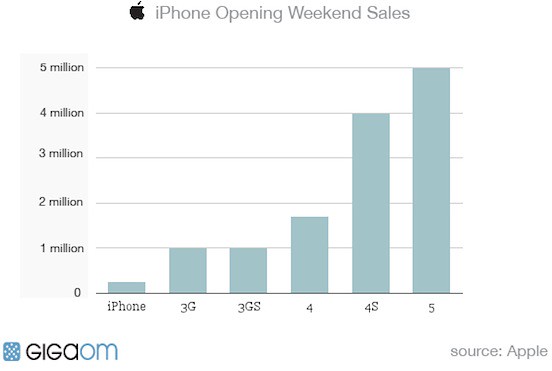There’s been a lot of discussion surrounding Apple’s 5 million sales figure for the iPhone 5 this past weekend, and the narrative seems to be focused on Apple selling fewer devices than analysts were expecting. And while it’s easy to lambast analysts for being, well, analysts, remember that expectations were arguably set when the number of pre-orders for the iPhone 5 was twice as high as it was for the iPhone 4S.
So what gives?
Some analysts are astutely pointing out that Apple’s 5 million sales figure doesn’t take into consideration pre-orders that have yet to be delivered to customers. As such, some estimate that there may be 1 million devices, if not more, still in transit and awaiting customer signatures before being added to the iPhone 5 sales tally.
Further, there have been reports that Apple retail stores were fully stocked with iPhone 5s while other retailers – such as Radio Shack and Best Buy – had exceptionally low quantities at launch.
Assuming that these reasons are, in fact, behind the lower-than-expected 5 million sales figure, why is this the case? How did Apple find itself in this situation?
Addressing that very question, Horace Dediu of Asymco has a pretty cogent explanation.
Some channels like Apple Stores may have gotten too many units while other channels like their on-line store, operator stores or retail partners did not get enough.
In other words, we have a situation of over- and under-supply (or over- and under-demand) simultaneously because the product is misallocated.
…
It’s possible that this year a larger group of consumers decided that braving long lines is not their cup of tea. Instead, this larger proportion could have chosen to bravely endure waiting for a package at home rather than the companionship of their fellow man. Maybe the population of buyers is broader this year as one would expect from such a large base, and there are fewer who have the time or inclination to queue for a device.
If the shift to online from in-store was unforeseen, the company could easily have allocated too many units to retail and not enough to online resulting in weeks-long waits for orders placed online and relatively short waits in queues.
At the end of the day, this is hardly a problem or a cause for concern for investors. Launch day sales figures for the iPhone 5 were 25% higher than they were for the iPhone 4S and the crux of the problem is that Apple is having trouble meeting surging demand.
Truthfully, that’s a problem that any other smartphone manufacturer would absolutely love to have. And besides, Apple’s international rollout of the iPhone 5 is much more expansive than it’s been for previous iPhone models, with Dediu noting that the 4S launched in 7 countries in 2011 with a combined population of 703.7 million people and sold 4 million units. “The iPhone 5,” Dediu points out in comparison, “launched into nine countries in 2012 with a total combined population of 709 million and sold 5 million in the same amount of time.”
“That means that 0.57% of the addressable market bought an iPhone 4S in three days and 0.71% bought an iPhone 5,” Dediu adds.
The takeaway is that there’s absolutely nothing to worry about, and if a company can sell 5 million units of anything in one weekend and have that looked upon as a failure, well, we’d venture to say that they’re doing things exactly right.




 Apple’s announcement that they had sold 5 million iPhone 5’s this past weekend is certainly impressive, but is well below the 6-8million estimate some analysts were initially anticipating. And even though initial iPhone 5 sales are 25% higher than iPhone 4S sales were, shares of Apple have tumbled in early Monday morning trading.
Apple’s announcement that they had sold 5 million iPhone 5’s this past weekend is certainly impressive, but is well below the 6-8million estimate some analysts were initially anticipating. And even though initial iPhone 5 sales are 25% higher than iPhone 4S sales were, shares of Apple have tumbled in early Monday morning trading.



Tue, Sep 25, 2012
Comments Off on Verizon iPhone 5 is GSM unlocked